The Colbert class were a pair armored frigates and central battery ironclad of the French Navy built in 1870-78. They were improved Richelieu authorized by the 1897 naval program, reverting to a single shaft for 14 knots for a displacement of 8,800 tonnes, originally fitted with two 274mm, one 240, six 138mm guns. They alternated as flagships for the commander and deputy commander of the Mediterranean Squadron in their careers, took part in the French conquest of Tunisia, notably the operation on Sfax in 1881. They were versed as auxiliaries in 1894–95 and discarded in 1900, sold in 1909.
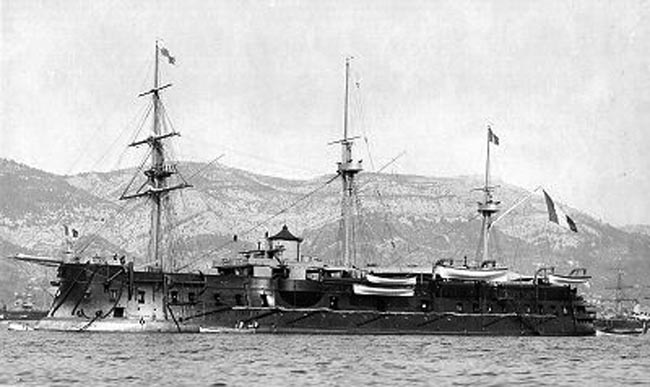
The Colbert in Toulon, photo by Bougault.
Design of the Colbert class
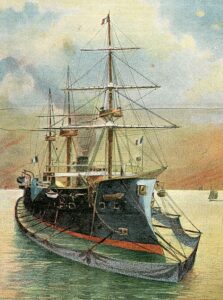 The Colbert class were essentially the same ships as Richelieu, when designed under the main naval Constructor (DNC) Sabattier. They were “improved” in a main way, which was to make them better sailing ships for long crossings. For this, it was believed Richelieu’s twin screw propulsion caused too much drag, so the Colbert class reverted to a single propeller solution. The other fear of the time is that a single prop under the long stern could lessen the chance of it being fouled by fallen rigging.
The Colbert class were essentially the same ships as Richelieu, when designed under the main naval Constructor (DNC) Sabattier. They were “improved” in a main way, which was to make them better sailing ships for long crossings. For this, it was believed Richelieu’s twin screw propulsion caused too much drag, so the Colbert class reverted to a single propeller solution. The other fear of the time is that a single prop under the long stern could lessen the chance of it being fouled by fallen rigging.
At that stage, theories on stability and specifications for ramming had her equipped with both a plough shaped ram bow, plough stern, and massive tumble home, making for a “spread” appearance characteristics kept on French capital ships until the late 1890s. This gave them however a low metacentric height above 0.6 meters (2 ft) up to 0.8 m (2 ft 6 in). As a result, she indeed rolled gently and slowly, making her a better gun platform.
The ram was not particularly reinforced. Her crew amounted to 774 officers and rating, and she had a menagerie of boats for different used, from bard coaler to small captain cutter.
But more importantly, they were the last French wooden hulled sea-going battleships. Indeed, the next will be the game changing Redoutable class, made in steel and iron, but the world’s first all steel warship nonetheless. The British Iris class cruisers came just afterwards.
Construction was slow, at Brest and Toulon, notably due to the major disruption in resources and men that was the Prussian War. Both ships also diveged in dimensions and displacement. Postwar, there was little money due to the huge reparation asked by Germany, to modernize the yards, and this explains not only the duration of construction but the sorry state in general of French Yards until the 1890s and subsequent limitations of French Battleships. It was not only the failings of the Jeune Ecole.
Hull
The Colbert class measured 101.1–102.1 meters (331 ft 8 in – 335 ft) overall. The beam was equally generous at 17.57–17.7 meters (57 ft 8 in – 58 ft 1 in). Maximum draft was 8.11–8.58 meters (26 ft 7 in – 28 ft 2 in). Fill displacement between Colbert and Trident was 8,617 and 8,814 metric tons respectively (8,481–8,675 long tons).
Her hull was covered by copper sheating as an anti-fouling measure.
Powerplant
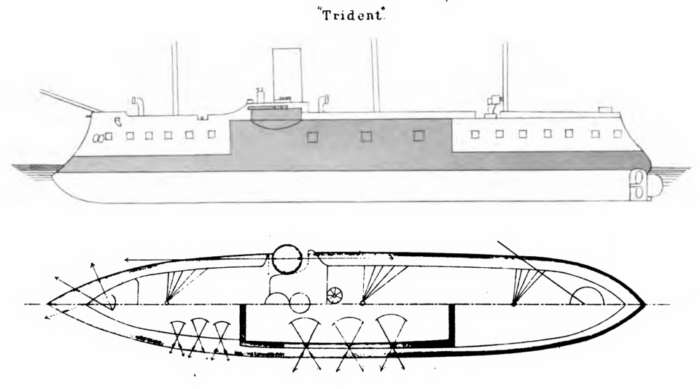
The Colbert class had had a single Wolf three-cylinder horizontal return connecting-rod compound steam engine. It drove one single fixed pitch bronze propeller like seen above, four bladed. This engine was powered by eight oval boilers. It was sold as having a capacity of 4,700 metric horsepower or 3,400 kilowatts (4,600 ihp). On sea trials the ships produced respectively 4,652 (Colbert) 4,882 (Trident) metric horsepower (3,422–3,591 kW) for speeds of 14.18 (Colbert) (26.26–26.80 km/h) or 14.47 knots (Trident) (16.32–16.65 mph).
They had an internal coal capacity of 620 metric tons (610 long tons), so enough to steam for approximately 3,300 nautical miles (6,100 km; 3,800 mi) at 10 knots (19 km/h; 12 mph) in economical speed, largely enough to criss-cross the Mediterranean, operate with the Atlantic fleet, or transit to Indochina. The Colbert class were fully rigged with three masts and had a sail surface of around 2,100 square meters (23,000 sq ft) or 2,140 m2 in other sources. British report also notes they both had steam steering, making them very handy, notably to compensate for the return to a single prop.
Protection
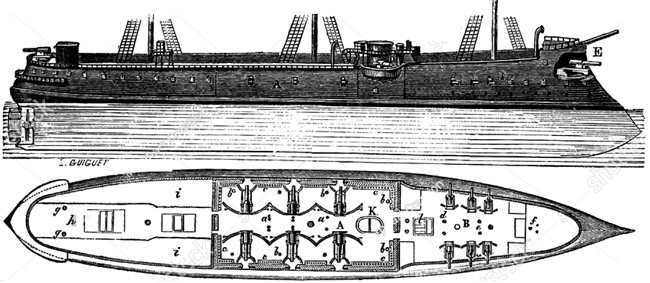
The Colbert class had had a complete wrought iron waterline belt, 220 millimeters (8.7 in) thick amidships, then tapered down to 180 millimeters (7.1 in) at the stern.
This belt was backed by 89 millimeters (3.5 in) of teak wood, 1.8m high. Its unarmoured wooden sides above were plated by 15 mm iron.
The battery above was protected 160 millimeters (6.3 in) of wrought iron, backed by 62 millimeters (2.4 in) of teak.
The battery ends were protected against raking fire by transverse armored bulkheads, 120 millimeters (4.7 in) thick, backed by 480 millimeters (18.9 in) of teak.
The barbettes were unarmored.
The deck was 15 millimeters (0.59 in) thick.
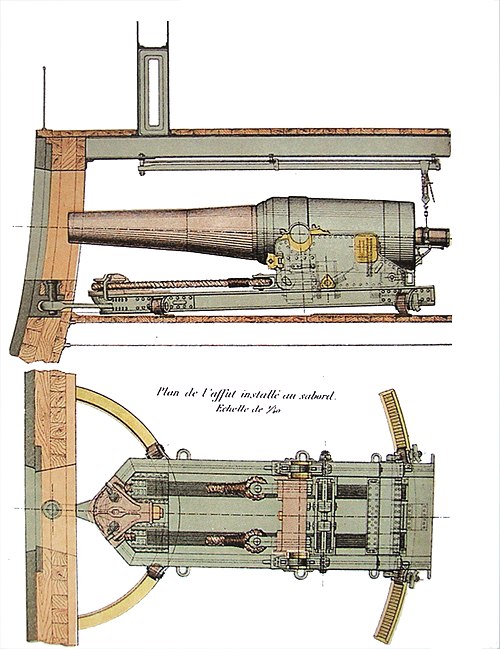
Cut of the battery deck showing the 160 mm wrought iron armour and its 62 mm teak backing, then the wooden hull, protecting the 27 cm guns.
Armament
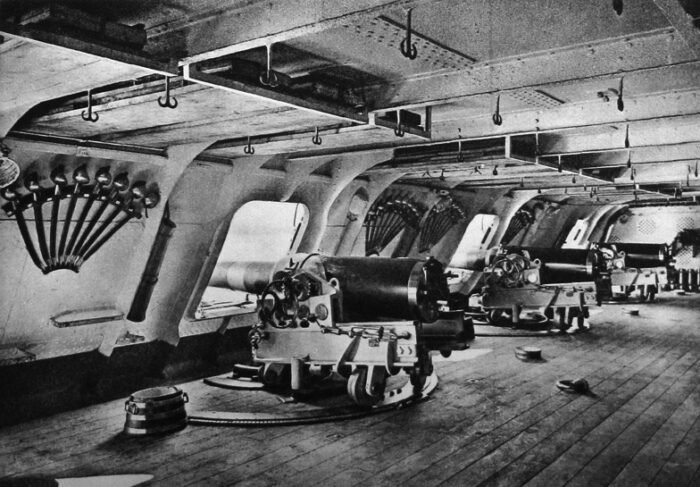
The Battery deck, Neurdein photo
The Colbert’s battery was shorter than in the Richelieu, with eight 274mm guns total, mounted in barbettes on the upper deck, with two in unarmoured barbettes in the upper works, forward corners, much recessed to give them a wide arc of fire. There was a single 240mm gun was forward under the forecastle, as chase gun, the second added shortly after completion in place of two 139 mm at the stern on a centre pivot mount, with light protection as chase gun. Since they were delivered in 1878, they were also equipped with four above-water 356mm (14 in) torpedo tubes as well.
Main: Four Barbette 274 cm (10.8 in) M1870
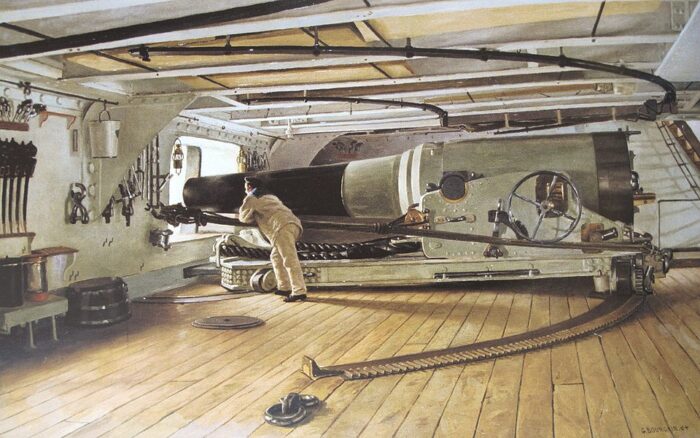
These guns weighed 23.21 metric tons (22.84 long tons). Their cradle mount framing was placed on concentric rails for maximum traverse.
These guns could fire both solid shot, and explosive shells. The 18-caliber 274-millimeter Modèle 1870 however relied on their armour-piercing job on 216.0-kilogram (476.2 lb) AP shells.
They flew at a muzzle velocity of 434 m/s (1,424 ft/s) and were credited to penetrate 360 millimeters (14.3 in) of wrought iron armor, at the muzzle (short distance).
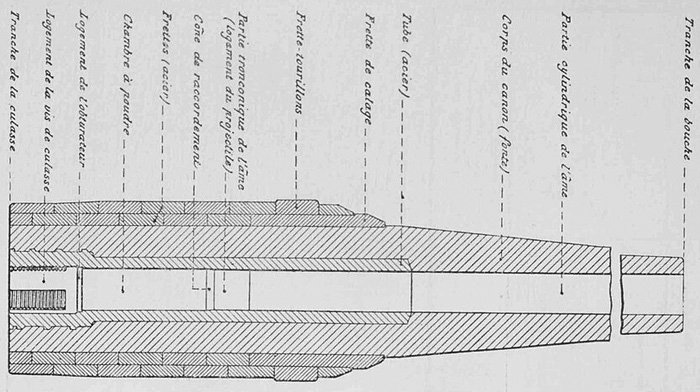
Secondary: Two 24 cm (9.4 in)

Gun weight 15.66 metric tons (15.41 long tons), 19-caliber.
Armor-piercing shell 144 kilograms (317.5 lb)
Muzzle velocity 495 m/s (1,624 ft/s)
Was credited to penetrate 366 mm (14.4 in) of wrought iron armor at the muzzle.
Characteristics 240 mm (1870M):
Type: Separate-loading, bagged charge and projectiles
Mass & Dimensions: 15,660 kg or 15.41 long tons, 4.940 m (16.21 ft) L/21.
Shell: AP 317.5 pounds (144.0 kg). Muzzle velocity 1,624 ft/s (495 m/s). Penetration 14.4 inches (366 mm) wrought iron at the muzzle.
Elevation/rate of fire: 30°, 1 round every two minutes.
Effective range: 10 km (6.2 mi) basic and 10.8 km (6.7 mi) for the 1870 M
Secondary: Six 138 mm (5.4 in)
These 138-millimeter gun were 21 calibers long for a weight of 2.67 metric tons (2.63 long tons).
They fired a 28 kg (61.7 lb) explosive shell (HE) at a muzzle velocity of 466 m/s (1,529 ft/s).
They were also was capable of fitring classic solid shots, to use against fortifications. This was done during the siege of Sfax and Moroccan Campaign at large.
Later: 47/37 mm Hotchkiss (6-3 pdr.)
Later in their career, the Colbert class received fourteen to eighteen 37-millimeter (1.5 in) Hotchkiss 5-barrel revolving guns.
They fired a 500 g (1.1 lb) shell at a muzzle velocity of about 610 m/s (2,000 ft/s) and to a range of about 3,200 meters (3,500 yd) with a rate of fire of 30 rounds per minute.
TTs: 2-4 356 mm tubes (14 in)
Unlike in Richelieu which only received two above water TTs in 1884, the two Colbert had from the start four above-water 356-millimeter (14.0 in) torpedo tubes from the start, covering all angles, bow, stern and broadside. The reserve of torpedoes is unknown.
profile conways
⚙ Colbert class specifications |
|
| Dimensions | 101.1–102.1 x 17.57–17.7 x 8.11–8.58 m (331 ft 8 in/335 ft x 57 ft 8 in/58 ft 1 in x 26.6–28.1 ft) |
| Displacement | 8,614–8,814 metric tons (8,478–8,675 long tons) |
| Propulsion | 1 shaft HRCR steam engine, 8 oval boilers: 14,700 PS; 3,400 kW (4,600 ihp) |
| Speed | 14 knots (26 km/h; 16 mph) |
| Range | 3,300 nautical miles (6,100 km; 3,800 mi) at 10 knots (19 km/h; 12 mph) |
| Armament | 8x 274 mm (10.8 in), 2× 240 mm (9.4 in), 6× 138 mm (5.4 in), 4× 356mm (14 in) TTs |
| Protection | Belt 180–220 mm (7.1–8.7 in), Battery 160 mm (6.3 in), Bulkheads 120 mm (4.7 in), Deck 15 mm (0.6 in) |
| Crew | 750 |
Colbert class career (1876-1900)
 Colbert (1875)
Colbert (1875)
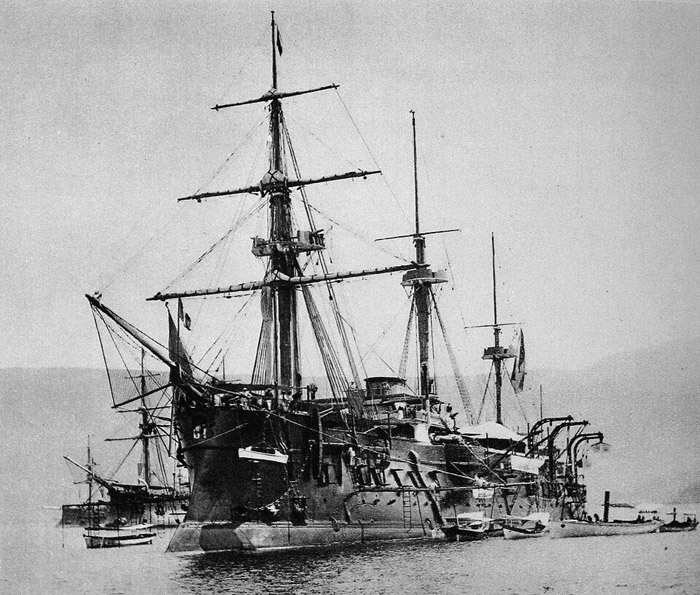
Colbert was named after Jean-Baptiste Colbert, Controller-General of Finances from 1665 to 1683 under King Louis XIV and with Cardinal Richelieu, one of greatest organizer of the French Navy. She was laid down at Arsenal de Brest, on 4 July 1870, launched on 16 September 1875 and completed on 30 June 1877. Between a drastic budget reduction after the Franco-Prussian War of 1870–71 and out-of-date work practices in the dockyard, plus shortages, she was only able to perform her sea trials on 23 May 1877. She became flagship of the Reserve Squadron on 31 August 1878. On 1 October 1879 she was flagship of the Mediterranean Squadron until 14 January 1890, the placed in reserve. She was fully reactivated for the Campaign or Tunisia. She notably bombarded the Tunisian port and barbary pirates stronghold of Sfax on 15–16 July 1881 during the French occupation.
In May 1887, she took part in exercises of convoy escort and protected the troops going to French North Africa, with the understanding they all would be retransported back to Europe in case of a major war. She remained assigned to escort convoys of four simulated troop ships with Courbet, Amiral Duperré, Indomptable. She played the “blues” in this scenario, with the “reds” being an enemy squadron of cruisers and torpedo boats trying to intercepting the convoy. Bad weather was used at their advantage to make the passage, heavy seas keeping torpedo boats to close on them or to operate at all.
Colmbert then became flagship of the Reserve Squadron from 12 April 1892 until disarmed, paid off in 1895. She was condemned (stricken) on 11 August 1900, and then sold for scrap in 1909.
 Trident (1876)
Trident (1876)
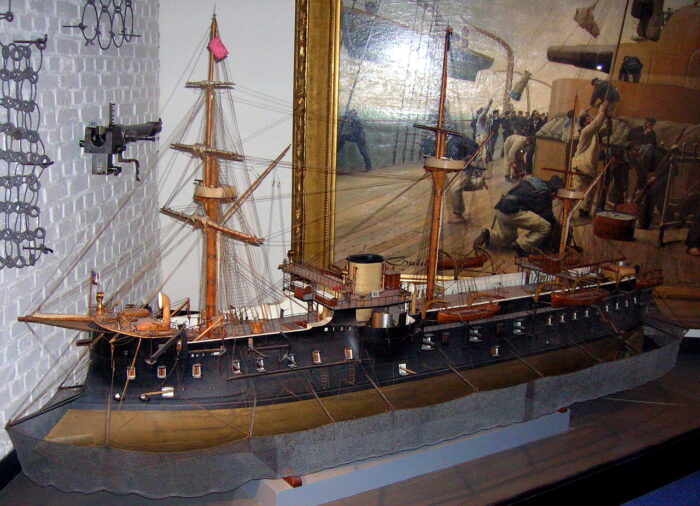
Trident (after Neptune’s iconic weapon and symbol of French’s mastery of the Mediterranean) was laid down at Arsenal de Toulon, on April 1870, launched on 9 November 1876 and completed on 18 November 1878. She was delayed for the same causes as her sister, making her already obsolescelt when in commission. After sea trials and being fully accepted for service she became the flagship of the second-in-command, Mediterranean Squadron the following month, with her sister being the overall flagship. Trident and Colbert after some reserve time, took part in the Tunisian invasion, and bombarded Sfax on 15–16 July 1881 to cover the occupation forces. She was disarmed and placed in reserve again in 1886–89, but was recommissioned (and modernized) on 17 February 1889, returning as flagship until regaining the in reserve in 1894. She became a gunnery training ship until stricken on 5 March 1900. She became “Var” in 1904 to free her name, and was sold for BU in 1908.
Read More/Src
Books
de Balincourt, Captain; Vincent-Bréchignac, Captain (1975). “The French Navy of Yesterday: Ironclad Frigates”. F.P.D.S. Newsletter. III
Campbell, N. J. M. (1979). “France”. In Chesneau, Roger & Kolesnik, Eugene M. (eds.). Conway’s All the World’s Fighting Ships 1860–1905.
Brassey, Thomas (1888). The Naval Annual 1887. Portsmouth, England: J. Griffin.
Roberts, Stephen S. (2021). French Warships in the Age of Steam 1859–1914: Design, Construction, Careers and Fates. Seaforth Publishing.
Ropp, Theodore (1987). The Development of a Modern Navy: French Naval Policy 1871–1904. NIP
Saibene, Marc (1995). “The Redoubtable, Part III”. Warship International. XXXII (1). Toledo.
Silverstone, Paul H. (1984). Directory of the World’s Capital Ships. Hippocrene Books.
Wilson, H. W. (1896). Ironclads in Action: A Sketch of Naval Warfare From 1855 to 1895. Vol. 2. Boston, Massachusetts: Little, Brown.
Links
https://www.battleships-cruisers.co.uk/colbert_class.htm
https://www.navypedia.org/ships/france/fr_bb_colbert.htm
https://en.wikipedia.org/wiki/Colbert-class_ironclad

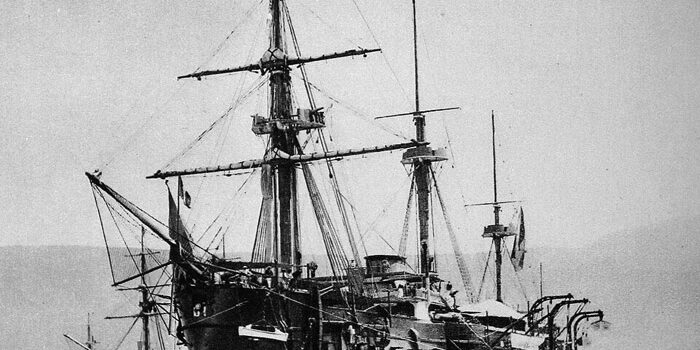

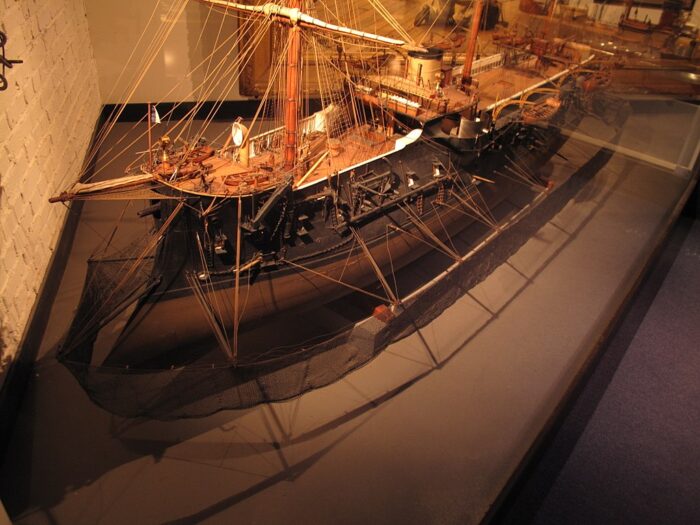
 Latest Facebook Entry -
Latest Facebook Entry -  X(Tweeter) Naval Encyclopedia's deck archive
X(Tweeter) Naval Encyclopedia's deck archive Instagram (@navalencyc)
Instagram (@navalencyc)





 French Navy
French Navy Royal Navy
Royal Navy Russian Navy
Russian Navy Armada Espanola
Armada Espanola Austrian Navy
Austrian Navy K.u.K. Kriegsmarine
K.u.K. Kriegsmarine Dansk Marine
Dansk Marine Nautiko Hellenon
Nautiko Hellenon Koninklije Marine 1870
Koninklije Marine 1870 Marinha do Brasil
Marinha do Brasil Osmanlı Donanması
Osmanlı Donanması Marina Do Peru
Marina Do Peru Marinha do Portugal
Marinha do Portugal Regia Marina 1870
Regia Marina 1870 Nihhon Kaigun 1870
Nihhon Kaigun 1870 Preußische Marine 1870
Preußische Marine 1870 Russkiy Flot 1870
Russkiy Flot 1870 Svenska marinen
Svenska marinen Søværnet
Søværnet Union Navy
Union Navy Confederate Navy
Confederate Navy Armada de Argentina
Armada de Argentina Imperial Chinese Navy
Imperial Chinese Navy Marinha do Portugal
Marinha do Portugal Mexico
Mexico Kaiserliche Marine
Kaiserliche Marine 1898 US Navy
1898 US Navy Sovietskiy Flot
Sovietskiy Flot Royal Canadian Navy
Royal Canadian Navy Royal Australian Navy
Royal Australian Navy RNZN Fleet
RNZN Fleet Chinese Navy 1937
Chinese Navy 1937 Kriegsmarine
Kriegsmarine Chilean Navy
Chilean Navy Danish Navy
Danish Navy Finnish Navy
Finnish Navy Hellenic Navy
Hellenic Navy Polish Navy
Polish Navy Romanian Navy
Romanian Navy Turkish Navy
Turkish Navy Royal Yugoslav Navy
Royal Yugoslav Navy Royal Thai Navy
Royal Thai Navy Minor Navies
Minor Navies Albania
Albania Austria
Austria Belgium
Belgium Columbia
Columbia Costa Rica
Costa Rica Cuba
Cuba Czechoslovakia
Czechoslovakia Dominican Republic
Dominican Republic Haiti
Haiti Hungary
Hungary Honduras
Honduras Estonia
Estonia Iceland
Iceland Eire
Eire Equador
Equador Iran
Iran Iraq
Iraq Latvia
Latvia Liberia
Liberia Lithuania
Lithuania Mandchukuo
Mandchukuo Morocco
Morocco Nicaragua
Nicaragua Persia
Persia San Salvador
San Salvador Sarawak
Sarawak Uruguay
Uruguay Venezuela
Venezuela Zanzibar
Zanzibar Warsaw Pact Navies
Warsaw Pact Navies Bulgaria
Bulgaria Hungary
Hungary

 Bundesmarine
Bundesmarine Dutch Navy
Dutch Navy Hellenic Navy
Hellenic Navy Marina Militare
Marina Militare Yugoslav Navy
Yugoslav Navy Chinese Navy
Chinese Navy Indian Navy
Indian Navy Indonesian Navy
Indonesian Navy JMSDF
JMSDF North Korean Navy
North Korean Navy Pakistani Navy
Pakistani Navy Philippines Navy
Philippines Navy ROKN
ROKN Rep. of Singapore Navy
Rep. of Singapore Navy Taiwanese Navy
Taiwanese Navy IDF Navy
IDF Navy Saudi Navy
Saudi Navy Royal New Zealand Navy
Royal New Zealand Navy Egyptian Navy
Egyptian Navy South African Navy
South African Navy






























 Ukrainian Navy
Ukrainian Navy dbodesign
dbodesign